NCERT Solutions for Class 6 English Poorvi Unit 5 Chapter 14: NCERT Solutions for Class 6 English Poorvi Unit 5 Chapter 14, The Kites, are crafted according to the latest exam pattern and CBSE syllabus. This poem celebrates the joy of flying kites and captures the vivid imagery of kites soaring high in the sky.
These solutions provide accurate, easy-to-understand answers that help students grasp the poem’s meaning, themes, and vocabulary. Aligned with syllabus guidelines, they support better exam preparation by enhancing comprehension and analytical skills. These resources are ideal for revision and practice, making them essential for scoring well in school assessments and CBSE Class 6 exams.
NCERT Solutions for Class 6 English Poorvi Unit 5 Chapter 14 Introduction
The Kites is a delightful poem that celebrates the joy and freedom of kite flying. Through simple yet vivid language, the poet paints a lively picture of colorful kites soaring in the blue sky, dancing with the wind.
The poem captures the excitement children feel while flying kites and the beauty of watching them glide and dip. It also subtly reflects the ups and downs of life, much like a kite's journey in the sky. This chapter encourages students to appreciate nature and find happiness in simple pleasures.
NCERT Solutions for Class 6 English Poorvi Unit 5 Chapter 14 The Kites
Below we have provided the NCERT Solutions for Class 6 English Poorvi Unit 5 Chapter 14 The Kites. These solutions include all textbook questions, activities, and exercises based on the latest CBSE syllabus. Students can refer to them for better understanding, exam preparation, and revision. All answers are explained clearly to help improve comprehension and language skills.
Let Us Do These Activities Before We Read
I. Answer the following questions and share them with your teacher and classmates.
1. Have you ever flown a kite or seen someone fly it? Where? When?
Yes, I have flown a kite during Makar Sankranti on the terrace of my house.
2. Describe the kite—colour(s), shape, design of tail, any other detail.
The kite was diamond-shaped, red and yellow in colour with a long colourful tail made of ribbons.
3. What did you think when you saw the kite up in the sky?
I felt excited and free, as if the kite was dancing joyfully in the wind.
II. Search the internet for videos on Kite Festivals and watch them with your teacher and classmates.
1. Share the things with your teacher that you saw and what the people were doing.
I saw people flying large, colourful kites of different shapes. They were enjoying and celebrating with music and food.
2. Would you like to participate in this kind of festival? Why?
Yes, because it looks like great fun and a way to celebrate culture with family and friends.
3. What kind of kite would you like to fly?
I would like to fly a kite shaped like a bird with bright wings.
III. Look at the picture and complete the sentences. Share your responses with your teacher.
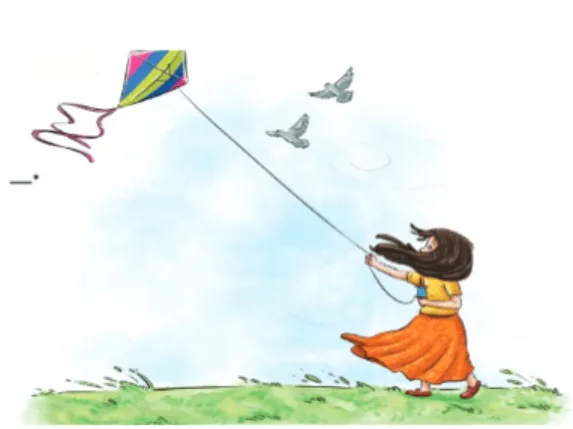
1. I can see birds, kite flying, sky in the picture.
2. The weather in the picture is windy.
3. The kite is flying high in the sky.
4. The child is looking from below.
5. The tail of the kite has ribbons.
IV. Now, think and answer.
1. List two more things that you want to add to the picture.
A rainbow and clouds.
2. If I were the child, I would run across the field while flying the kite.
3. If I were the kite, I would soar above the trees and touch the clouds.
Let Us Discuss
I. Read the poem silently. As you read, mark the given statements as True or False.
-
The child is looking at the kites. – True
-
The kites look like birds of different colours. – True
-
It was a rainy day. – False
-
The child wants to be like a kite. – True
-
The child wishes to climb on a kite. – True
-
The kite is made of cloth and plastic. – False
-
The child wants to ride the kite. – True
-
The child knows they would have fun. – True
-
The child wants to look at the kite from a rooftop. – False
-
The child would like to look at people down below. – True
-
The child knows that the people would stare. – TrueII. Complete the following sentences.
1. The poet says that the kites are like coloured birds –
The kites have been compared to birds because they fly high and have many colours.
2. The child wishes to be like air –
The child wishes to be as light as air. The child wishes this to be able to climb on a kite and fly.
III. Find a set of words from the poem that begin with the same consonant sound.
Stanza 1: wind-whipped
Consonant sound: W
Stanza 3: paper – park
Consonant sound: P
Create 4 other sets of words using alliteration:
-
Bright blue bird
-
Happy hopping hare
-
Silly singing squirrel
-
Fast flying fish
IV. In the last stanza, the two words that the poet repeats are high, high to tell us that the kite is flying very high.
V. Study each stanza and underline the rhyming words from the end of each line. Also, circle the end words in the stanzas that do not rhyme.
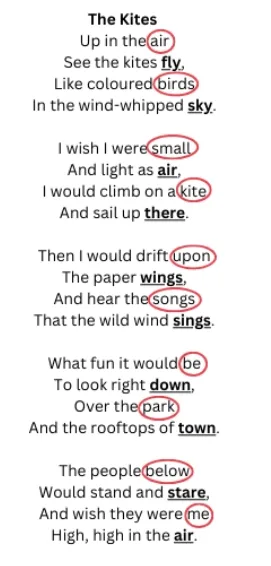
Examples:
-
fly – sky
-
air – there
-
wings – sings
-
down – town
-
stare – air
Let Us Think and Reflect
I. Read the given lines from the poem and answer the following questions.
1. Circle the word that does not share the same feeling as ‘fun’: joy, excitement, care, happiness.
Answer: care
2. Which line tells us that the poet was somewhere above?
Answer: "To look right down"
3. Choose the scene the child saw.
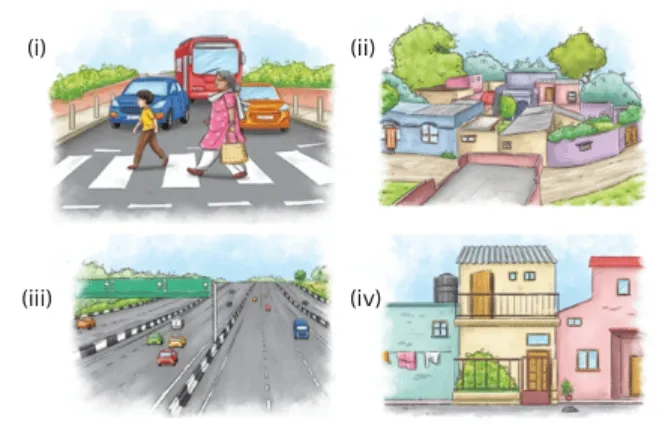
Answer: (iv)
— Over the park and the rooftops of town
II. Answer the following questions.
1. How does the poet describe the kites in the first two lines?
As coloured birds in the wind-whipped sky.
2. Why does the child say that they have to climb a tree first to get onto the kite?
Because they wish to reach the kite high up in the sky and imagine themselves climbing onto it like a branch.
3. What are the songs that the child hears when flying atop the kite?
The songs that the wild wind sings.
4. Why did the people look up at the child and stare? If you looked up and saw that, what feelings would you have?
Because the child is flying on a kite high in the sky. I would feel surprised and amazed.
5. If you were the kite carrying the child high up in the air, what would you tell them?
I would say, “Hold tight, let’s touch the clouds and dance with the wind!”
Let Us Learn
I. Complete the given conversation using kite parts.
Bina : I like the long tail at the end of my kite. What is your kite like?
Saroj : My kite’s cover is bright. The spine is black.
Bina : Oh wonderful! My kite’s line is attached to the reel that wraps it. I really like it.
Saroj : Did you know that the tip of a kite is called a nose?
Bina : Wonderful! Thanks for letting me know. Let's go and fly our pretty kites.
II. Cinquain Poem Example
Kite
Bright, playful
Flying, drifting, dancing
Gracefully, freely
Sky-bird
Now write your own poem following the same format.
III. Movement-related activity
1. Circle the words that match with the ‘drift’ movement:
slow, downward, float
2. Movement meanings:
-
Glide – smooth and slow movement
-
Dive – quick downward motion
-
Soar – rise high and steadily
-
Swoop – swift downward movement
-
Circle – move in a round path
IV. Expressions and usage
Expressions: up in the air, look right down, stay up there, stand and stare
Example Sentences:
-
I saw my kite fly up in the air.
-
From the rooftop, I could look right down on the garden.
-
I wished my kite would stay up there forever.
-
People stopped to stand and stare at the huge kite.
Let Us Listen
(Listening activity – use textbook transcript)
Correct answers:
-
False – (Correct: January)
-
False – (Correct: Western India)
-
True
-
True
-
True
-
True
-
False – (Correct: On Makar Sankranti)
Let Us Speak
(Your response example)
Last year, I watched kites being flown during Makar Sankranti from our terrace. It was in the morning, and the sky was full of colourful kites. My cousins were flying the kites, and I helped them hold the reels. It was so much fun!
Let Us Write
I am a Kite (100-word paragraph)
I am a bright diamond-shaped kite with red and yellow colours and a long ribbon tail. I belong to a little boy who flies me with joy on sunny, windy days.
My home is the big open sky where I glide and twirl happily with other kite friends. I love the wind that carries me far above the rooftops. I can see everything below — houses, trees, and people looking up. My message to humans is to take a break from screens and come outside. Fly a kite, feel the wind, and enjoy nature like I do!
Let Us Explore
1. Find out the steps to make a kite.
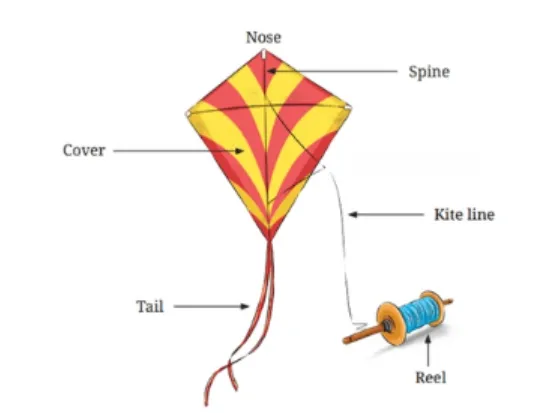
-
Take a sheet of paper or plastic.
-
Cut it into a diamond shape.
-
Attach two sticks (spine and crossbar) to form a frame.
-
Tape the sticks to the back.
-
Add a string to the spine for flying.
-
Decorate and add a tail with ribbon or fabric.
Now, complete the given conversation by filling in the blanks with some ‘parts of a kite’ words from above.
Bina: I love the long yellow t _ _ _ at the end of my kite. What colour is your kite?
Saroj: My kite’s c _ _ _ _ is pink. The s _ _ _ _ e is black.
Bina: Oh wonderful! My kite l _ _ _ is red. The r_ _ l that wraps it is green. I like it.
Saroj: My kite line is red too. The tip of my kite has a blue _ _ _ e.
Bina: Beautiful! Let’s go and fly our pretty kite.
Answer:
Bina: I love the long yellow tail at the end of my kite. What colour is your kite?
Saroj: My kite’s cover is pink. The spine is black.
Bina: Oh wonderful! My kite line is red. The reel that wraps it is green. I like it.
Saroj: My kite line is red too. The tip of my kite has a blue nose.
Bina: Beautiful! Let’s go and fly our pretty kites.
2. Let us create a poem using words in a kite!
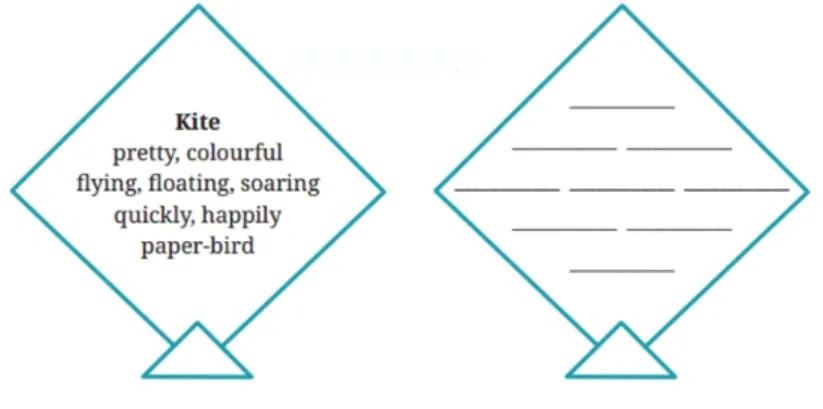
This is called a cinquain poem. It is a five-line poem that describes a person, a place or a thing. Now, create a cinquain poem yourself on anything you like.
Answer:
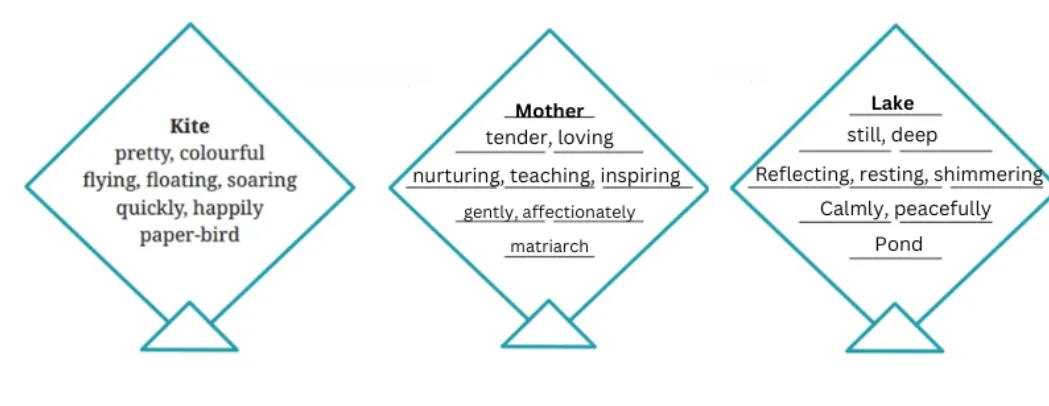
Let us listen (Page 148)
Hello everyone! I’m happy to share with you some details about the Kite Festival. It is a popular festival in India and it takes place during Makar Sankranti in the month of January.
People can even be seen flying kites from their terraces and rooftops and taking part in kite flying competitions. This festival is celebrated as Uttarayan in Western India.
The festival gives everyone a chance to look at kites of different shapes, sizes and colours. Gujarat is the main centre of celebrations but Uttarayan is also celebrated in Rajasthan
and Telangana.
In Karnataka, the Tourism Department has also been organising the kite festival once each year. Punjab also celebrates this festival of kites during Baisakhi and Basant Panchami.
Kite flying is a tradition that is deep-rooted in Indian culture and the Kite Festival is one that is eagerly awaited.
This is also a reason why people across India also fly kites to celebrate Independence Day. Happy kite-flying to all of you!
Listen about the Kite Festival in India. As you listen, circle the words that are not correct. Then, listen again and write the correct words. (refer topage 163 for transcript)
(a) Kite Festival is celebrated during the month of June.
(b) The International Kite Festival is named Uttarayan in Eastern India.
(c) Uttarayan is mainly celebrated in Gujarat, but also in Maharashtra
and Telangana.
(d) During the Kite Festival, we can see kites of different shapes, sizes
and colours.
(e) In Karnataka, the Tourism Department organises the kite festival
every year.
(f) The Punjab region celebrates Basant Panchami and Baisakhi by
flying kites.
(g) People of India also enjoy flying kites on Earth Day.
Answer:
(a) Kite Festival is celebrated during the month of June.
Answer:
January
(b) The International Kite Festival is named Uttarayan in Eastern India.
Answer:
Western India
(c) Uttarayan is mainly celebrated in Gujarat, but also in Maharashtra and Telangana.
Answer:
Rajasthan
(d) During the Kite Festival, we can see kites of different shapes, sizes and colours.
Answer:
Correct
(e) In Karnataka, the Tourism Department organises the kite festival every year.
Answer:
Correct
(f) The Punjab region celebrates Basant Panchami and Baisakhi by flying kites.
Answer:
Correct
(g) People of India also enjoy flying kites on Earth Day.
Answer:
Independence Day
Let us explore (Page 149)
1. The mention of kites exists in ancient Indian texts. It can be found in the poetry of the thirteenth-century Marathi saint and poet, Namadeva. In his poems or gathas, he called a kite a gudi, and there is a mention that the kites were made from kaagad (paper).
2. Have a look at some of the different types of kites. Choose which one is commonly seen.
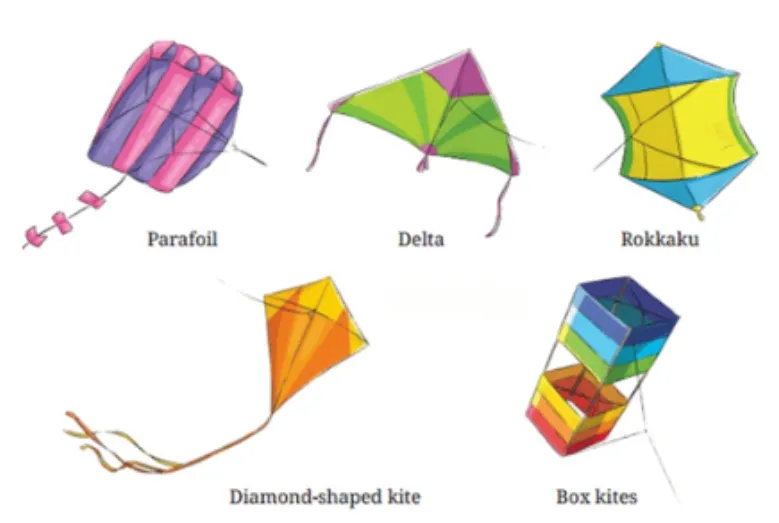
Answer:
The diamond-shaped kite is commonly seen.
2. Follow the steps and create your own kite.
3. Write a message on the kite.
Example: Fly High, Dream Big!
NCERT Solutions for Class 6 English Poorvi Unit 5 Chapter 14 PDF
Below we have provided the NCERT Solutions for Class 6 English Poorvi Unit 5 Chapter 14 The Kites in PDF format. This PDF includes detailed answers to all textbook questions, pre-reading activities, comprehension exercises, grammar tasks, and creative writing.
The solutions are prepared as per the latest CBSE Class 6 syllabus and exam pattern to help students with effective learning and revision. You can download and refer to this PDF for a complete understanding of the chapter and better exam preparation.
















